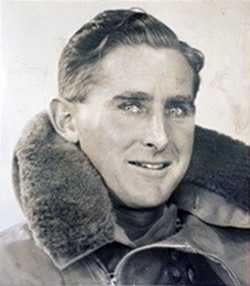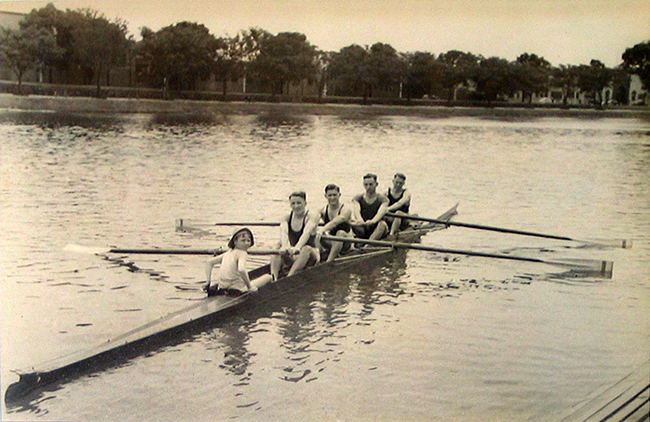R Ramsay Brewin

Richard Ramsay Brewin and his brother Raymond Thomas Brewin were active members of the Club in the 1930s. They were the classic Clubbies, the backbone of the Club rowing maiden and junior races over a long period of time with limited success. They both rowed in summer and both played rugby in winter with the Harlequin Rugby Club, a club which had a long association with Mercs. They rowed continuously from 1932 through to the war and won a race with famous members Arthur Atkins and Deane Morgan. And like Arthur, they were all in the air force. Sergeant Ramsay Brewin fought in WWII in a Beaufort Bomber – 100 Sqdn. and fortunately survived the war. His two brothers were not so lucky. Sergeant Ray Brewin was a Spitfire pilot 457-Sqdn. who failed to return after an operational sortie from the United Kingdom. Their half brother Patrick Hope Brewin, also killed in WWII, was a Warrant Officer in the Sunderlands 461 –Sqdn. serving in Sunderlands. He died at the age of 21 years on a operational sortie.
Now a quick mention of the rowing background of the Brewin brothers at Mercantile. They are bundled together as they raced most of their races together.
1932-33 – Ramsay Brewin was a senior member and raced unsuccessfully in a maiden pair at the Upper Yarra Regatta.
1933-34 – Both brothers were senior members were now senior members with Ramsey racing unsuccessfully at Henley in a maiden four.

1937 Maiden Four - Cox: John Williams, Str: T Raymond Brewin, 3: R Ramsey Brewin, 2: Arthur Atkins, Bow: Deane Morgan
1934-35 – Both brothers raced unsuccessfully together in a maiden eight at Bairnsdale and Sale.
1935-36 – Both brothers raced together in 10 regattas and in the last regatta of the season, they finally won a race in a maiden eight at Sale.
Novice Pair – VRA Regatta – defeated
Maiden Eight – Melbourne Regatta – defeated in heat
Maiden Eight – Henley – defeated
Maiden Eight – Nagambie – defeated
Maiden Eight – Footscray – defeated
Maiden Eight – Upper Yarra Regatta – defeated
Maiden Eight – Barwon – defeated
Maiden Eight – Ballarat – defeated (but the Mercantile No 1 crew won) – picture showing finish with 11 crews
Maiden Eight – Bairnsdale – defeated
Maiden Eight – Sale – a victory at last
1936-37 – Both brothers raced unsuccessfully at the Melbourne and Henley regattas.
Maiden Pair – Melbourne Regatta – won heat but lost final
Maiden Four – Henley – defeated in heat
1937-38 – Both brothers raced together in nine regattas winning a maiden four at Henley
Maiden Four – VRA Regatta – defeated in semi-final
Maiden Four – Henley – won
Maiden Pair – Nagambie – “were unfortunate to lose this event”. It sounds like something external occurred.
Maiden Pair – Rutherglen – defeated
Junior Four – Upper Yarra Regatta – narrow loss in the heat
Junior Four – ANA Regatta – unplaced
Junior Eight – Barwon – unsuccessful
Junior Eight – Bairnsdale – unsuccessful
Junior Eight – Sale – unsuccessful
1938-39 – The brothers raced unsuccessfully together at the VRA and Henley regattas;
Junior four VRA Regatta – defeated in their heat
Junior four Henley – defeated
1939-40 – Raymond Brewin raced in junior eights in two pre-Christmas regattas.
Ramsay did not row after the war. He married Beryl Myrtle Gyngell on 20th June 1941 and had one son, Raymond Ramsay Brewin.
Ramsay started off as a coach builder (panel beater) then worked with Gyngell Bros in the building industry. He worked as an estimator, accountant and supervisor building most of the California Bungalow style houses in Bentleigh. They lived in Robert Street Bentleigh for about 15 years before he built their house in 1 Inner Crescent Brighton. They lived there until the end. Both were good golfers and members of the Victorian Golf Club.
Ramsay was born 24th September 1911 and died 16th September 2001.
In 2015, their son Ray Brewin donated his father’s blue Mercantile blazer to the Club. It is on display in the Mercantile entrance hall. The blazer was the style used by the Club before it changed the logo to the present form in 1935. It is therefore likely to have been made in the early 1930s.
Andrew Guerin
April 2016

